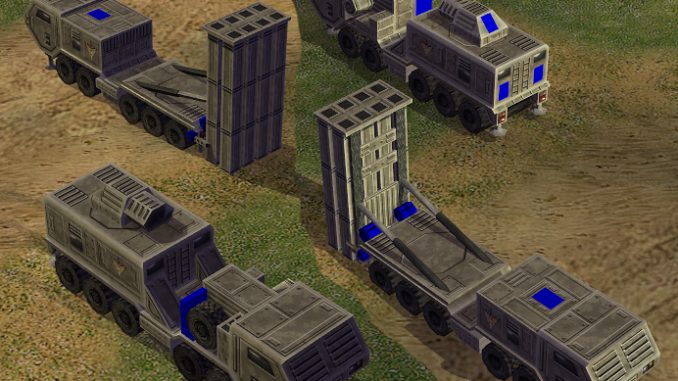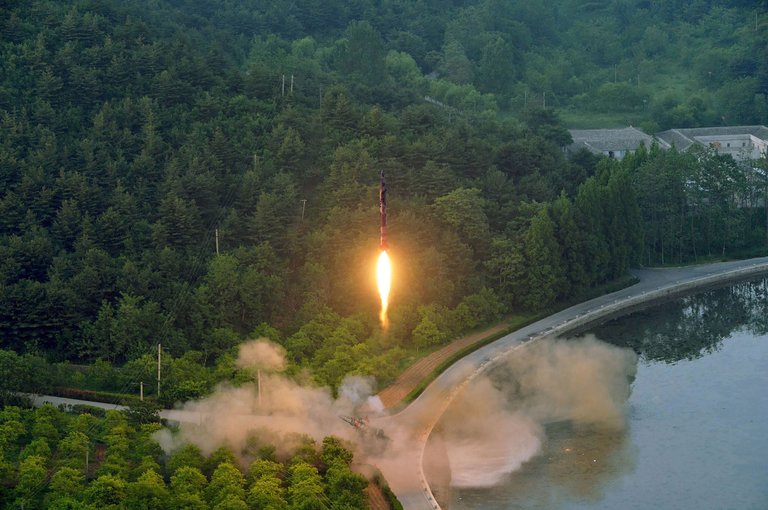
Moon accused US & impeached Pres Park Geun-hye of trying to make THAAD deployment fait accompli before May election. Called for parliamentary review of THAAD deployment during the campaign, for reasons now clear. Two interceptor-rocket launchers were first put in place in Seongju, 135 miles southeast of Seoul, during April deployment, although a THAAD battery normally operates with six launchers. “President Moon called it a great shock,” said spokesman. “He has ordered a probe into how the four launchers were brought into the country, whose decision it was, why it has not been made public to the people and why it has not been reported to the new government until now.” There was no immediate reaction from US military or South Korean Defense Ministry. Top: THAAD battery. Below: Undated photo released by North Korea’s official Korean Central News Agency Tuesday claimed to show test-firing of a ballistic missile at undisclosed location in North Korea.
President Moon Jae-in of South Korea has ordered an investigation into why
the Defense Ministry had failed to inform him that four additional launchers for a contentious US missile-defense battery had been brought into his country.
The US had hurried to deploy the antimissile system, called the Terminal High Altitude Area Defense, or THAAD, in late April,
despite protests from Moon, a presidential candidate at the time,
who demanded the deployment be delayed until AFTER the new government in Seoul was able to review whether it was in the country’s best interest.
The president’s move came as tensions on the Korean Peninsula were rising.
On Monday, Pyongyang launched what South Korean officials called a Scud-type missile that flew 280 miles before falling into waters near Japan.
Hours after the missile test, two US supersonic B-1B Lancer bombers conducted a drill over South Korea, the second such mission this month.
Moon and US Anti-Missile System Promotion – A Contentious Relationship
As a candidate, Moon had called for a parliamentary review of the THAAD system.
Two interceptor-rocket launchers were first put in place in Seongju, 135 miles southeast of Seoul, during the April deployment,
although a THAAD battery normally operates with six launchers.
Moon had accused both US and government of impeached President Park Geun-hye of trying to make THAAD deployment a fait accompli.
Since Moon’s election, he has not been as vocal about the THAAD deployment.
That changed on Tuesday, when he learned that the remaining four Thaad launchers had also arrived in South Korea —
although not put in place in Seongju —
and that his office has been kept in the dark about it.
“President Moon called it a great shock,” said his spokesman, Yoon Young-chan.
“He has ordered a probe into
- how the four launchers were brought into the country,
- whose decision it was
- why it has not been made public to the people and
- why it has not been reported to the new government until now.”
There was no immediate reaction from the United States military or the South Korean Defense Ministry.
THAAD – Key Piece in US / China / Korea / Japan Relationship
Many liberal domestic supporters of Moon have feared that THAAD deployment would do little to protect South Korea from North Korean missiles,
and instead bring their country deeper into a hegemonic struggle between the US and China.
They tend to see it as part of Washington’s scheme to contain China’s growing military influence with a regionwide missile defense network.
Their misgivings only deepened when President Trump suggested that South Korea pay $1 billion for the system.
China has also been boycotting South Korean brands in retaliation.
But Moon’s conservative foes regarded THAAD as a key to guarding against North Korea and condemned China’s economic retaliation as bullying.
Moon also departed from his conservative predecessor, Ms. Park, by calling for dialogue with the North,
saying that sanctions alone have failed to end the North’s nuclear ambitions.
But his approach has been challenged by North Korea’s growing missile threats since his election.
“The only way to make North Korea listen is through Chinese economic and American military pressure,”
Prime Minister Shinzo Abe of Japan told Moon on the phone on Tuesday, according to Moon’s office.
“This is not time for dialogue.
We must strongly call on China to stop providing oil and oil-related goods to North Korea.”
Moon agreed it was time to increase sanctions and pressure on North Korea.
The phone call between Abe and Moon took place hours after North Korea said on Tuesday that
the ballistic missile it tested this week could be launched much more quickly than others of its kind,
and that it could strike enemy ships and other targets with greater precision.
North Korea’s Increasingly Sophisticated Nuclear Capability
On Tuesday, the North’s official Korean Central News Agency said the missile had been equipped with a new precision guidance system.
It also had an advanced, automated prelaunch sequence, “markedly reducing the launching time,” the news agency said.
The North’s attempts to develop longer-range missiles have caused considerable alarm,
but Pyongyang has also been striving to improve its Scud-based short- and medium-range missiles,
which could strike targets in South Korea and Japan, including US military bases and aircraft carriers that often sail in nearby waters.
The South Korean military said Tuesday that it needed time to verify the North’s statement.
It was the latest in a series of advances in missile technology claimed by North Korea in recent weeks.
So far this year, North Korea has conducted nine ballistic missile tests, some of which analysts later said demonstrated new technologies.
Its midrange Pukguksong-2 used solid fuel, eliminating the need for a lengthy fueling process,
which means it can be rolled out from a concealed location and launched quickly.
The intermediate-range Hwasong-12, which the North tested on May 14, had a longer range than any missile it had launched before.
“Whenever news of our recent valuable victory is broadcast, the Yankees would be very much worried,
and the gangsters of the South Korean puppet army would get dispirited more and more,”
the North’s news agency quoted the country’s leader, Kim Jong-un, as saying after watching the launch on Monday.
North Korea has repeatedly claimed it could strike the continental US with a nuclear warhead,
but has never tested an intercontinental ballistic missile that can fly across the Pacific.
The Trump administration has been calling on China, North Korea’s main ally,
to bring “maximum pressure and engagement” to stop the North from reaching that goal.
Two American aircraft carriers, the Carl Vinson and the Ronald Reagan, are engaging in exercises in the western Pacific, not far from the Korean Peninsula.
Hours after the North’s missile test on Monday, the American B-1B Lancer bombers conducted their drill over South Korea.
The North’s statement on Tuesday noted these developments, referring to the flights as a “nuclear-bomb-dropping drill,” though Lancers are no longer nuclear-capable.
Source: South Korea Leader Orders Investigation Into Unreported U.S. Launchers – The New York Times
